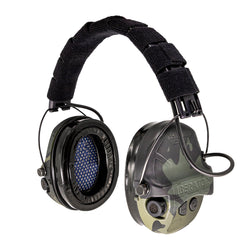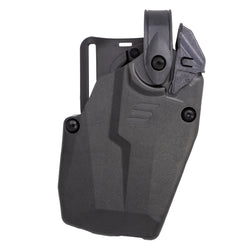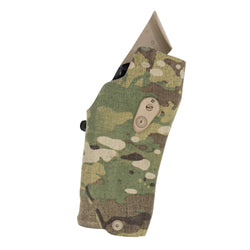As the United States Navy celebrates its 250th anniversary, one often overlooked part of its story needs to be told. That is of the “naval infantry,” where sailors served in the role now largely undertaken by the United States Marine Corps.
Although the Marines were founded only a month after the Continental Navy, landing parties were primarily made up of sailors, with the Marines being in the minority.

Sailors serving as infantry, and even providing land-based artillery support, were part of U.S. Naval operations and missions throughout the 19th century. As late as the 1970s, there were still sailors who received competency as naval infantry. The function of naval landing parties and sailors serving as infantry dated back practically to the founding of the Continental Navy during the American Revolution.
On April 23, 1778, the United States carried out a raid on Whitehaven, England, led by famed U.S. Navy officer John Paul Jones. Around 30 sailors from the USS Ranger rowed ashore and set fire to merchant ships in the harbor. The damage was minimal, but it went down in history as the first overseas combat mission conducted by the U.S. military.
It certainly wasn’t the last.
Throughout the 19th and into the 20th century, U.S. Navy sailors participated in land-based operations around the world. According to the U.S. Naval History and Heritage Command, there were at least 66 landings and operations where naval landing parties were engaged in the fighting.
The Battle of New Orleans
Jimmy Driftwood’s 1936 song “The Battle of New Orleans,” later made famous by singer Johnny Horton, may have offered a memorial version of the famed battle of the War of 1812. Still, it overlooks the significant role sailors played.
Ironically, history remembers the exploits of the pirate Jean Lafitte, but often overlooks the role of U.S. Navy Commodore Daniel Patterson, who has been credited with preparing the city’s defenses. In addition, about 100 U.S. Navy sailors and officers maintained a small flotilla that slowed the British advance, while captured sailors provided false information to the British.
During the Battle of New Orleans, Patterson commanded the naval contingent and helped organize sailors and Marines, who served on gun batteries on the right bank of the Mississippi.
The Seminole Wars, the Mexican Wars
As the United States Army was far from a large fighting force in the early 19th century, sailors served again as infantry during the Second Seminole War (1835–1842), operating in the Everglades and Florida’s riverine environments where traditional naval tactics proved ineffective.
The so-called “Swamp Sailors” were eventually able to disrupt Seminole resistance. A special unit, often referred to as the “Mosquito Fleet,” was also formed. It utilized small flat-bottomed boats and canoes to navigate the dense swamps and rivers, but much of the fighting was done as infantry.
Just four years after the end of the Second Seminole War, the United States found itself at war with Mexico, a nation with a navy. Under Commodores Matthew Perry, John Sloat, and Robert Stockton, sailors fighting as infantry played a crucial role in the capture of California and Mexican coastal cities.
In contrast, at Vera Cruz, sailors landed Home Squadron heavy guns and acted in the role of artillery. Sailors were employed in amphibious landings and to enforce blockades. Among the 20,000 U.S. military personnel led by General Winfield Scott during the Battle of Mexico City from September 8 to 15, 1847, were an unknown number of sailors.

It was during the Mexican-American War that it became clear that the U.S. Navy had no satisfactory gun to carry out the blockades. After the war, Lieutenant John A. Dahlgren, then assigned at the Washington Navy Yard, proposed and then helped develop the Dahlgren boat howitzer. The muzzle-loading guns were produced in three sizes, including a 12-pounder light howitzer, a 12-pounder medium howitzer, and a 24-pounder. All three could be adapted for use with either a boat or field carriage, with the medium version becoming the standard U.S. Navy infantry field piece until the late 19th century.
During the American Civil War, U.S. Navy sailors fought as infantry, notably when smaller warships were deployed on inland rivers, where a Marine presence was not warranted. In addition, sailors and Marines alike were trained to land and travel as much as 20 miles inland from rivers or coast, at times hauling small howitzers. U.S. Navy sailors were further assigned to operate shore-based artillery batteries to defend harbors and support naval operations.
Naval Infantry in the Late 19th Century
During the period, U.S. Navy regulations required a set number of sailors to be exercised and trained for infantry combat, excluding Marines. Additionally, U.S. Navy Ordnance Instructions mandated that the entire crew be exercised in the use of muskets, carbines, pistols, and swords. With the founding of the Naval Academy in 1845, cadets were taught infantry tactics as an integral part of the curriculum in both first and second class years.

In addition to being armed with 12-pounder medium howitzers, by the end of the 19th century, the U.S. Navy had adopted machine guns to support landing operations. The Colt-Browning M1895, commonly known as the “Potato Digger,” was the first automatic weapon to see service with the United States Navy and the U.S. Marine Corps. The Navy first tested the John Browning-designed weapon in 1893. Chambered in the U.S. Navy’s 6mm cartridge, it was mounted on tripods and carriages.

Even as technological advances brought about by the Industrial Revolution of the 19th century transformed wooden sailing ships into fully steel vessels, the role of the sailor as an infantryman continued. Infantry tactical doctrine, introduced in the 1890s, underwent continuous refinement and updates until the mid-1960s during the Cold War.

Naval Infantry in the 20th Century
In 1889, discussions even began whether Marines were needed to serve on ship guard and take other on-board duties. This debate continued until 1908, when President Theodore Roosevelt issued Executive Order 969 that redefined Marine Corps duties to exclude ship guard and other on-board responsibilities. While Congress actually reversed the decision, it was really the first salvo in the roles that sailors and Marines would play throughout the 20th century.

In the first three decades of the 20th century, the United States Navy continued to train personnel in infantry tactics, conduct of fire, and the defense of field fortifications. Additionally, there were approximately 136 instances in the Caribbean and Central America where sailors were deployed as infantry. Landing parties made the most valuable contribution by the United States Navy during the Philippine Insurrection.
The largest operation involving U.S. Navy sailors serving as infantry was during the occupation of Veracruz in 1914, where some 2,500 “Bluejackets” conducted a landing and infantry assault alongside 1,300 Marines. That engagement highlighted numerous shortcomings, notably that the massed infantry tactics of 1891 and earlier were ineffective in street fighting.
The Bluejackets from USS Olympia (C-6) were among the U.S. military forces deployed to northern Russia as part of Allied intervention during the Russian Civil War in 1918, deployed to Murmansk, where they took part in engagements with the Bolsheviks.

Advances in technology also led to the slow but eventual end of sailors serving as infantry. As warships became more complex, sailors were required to receive specialized training, which in turn lessened the role they could play as infantry. This coincided with an evolution of the United States Marine Corps.
Under the leadership of USMC Commandant General John A. Lejeune, the Marine Corps was reorganized with a greater focus on field operations, with amphibious infantry assault and infantry operations ashore acknowledged as its primary mission.

Despite this shift, U.S. Navy sailors still took on an infantry role, including operations along the Yangtze River in China in the 1930s. During World War II, sailors helped defend Bataan in the Philippines from Japanese attacks in early 1942 and assisted in the Operation Torch landings in Morocco later that same year.
The use of sailors as infantry was extremely limited during the Korean and Vietnam Wars. According to the U.S. Naval History and Heritage Command, although formal infantry training continued until the 1970s, the final instance of a ship landing party going ashore was during the Watts Riots in 1965 at the port of Long Beach, California.
Given that the United States military has put a renewed focus on “great power competition,” notably with China over concerns of a future war in the Indo-Pacific, sailors may once again play a role beyond their duties at sea.
This article is part of our series honoring the U.S. Navy’s 250th birthday—see the other stories in the series for more history and insights.
Origins of the U.S. Navy
- 13 October 1775: The Birth of a Sea Power.
- John Paul Jones: Father of America’s Navy
- The History of the U.S. Navy’s First Six Frigates
- U.S. Naval Battles of the Revolutionary War
Navy Pioneers & Heroes
- History of U.S. Naval Infantry
- Forged in Fire: The Origins of the Navy SEALS
- Unsung Heroes of the U.S. Navy
Naval Hardware
Honoring the Legacy









